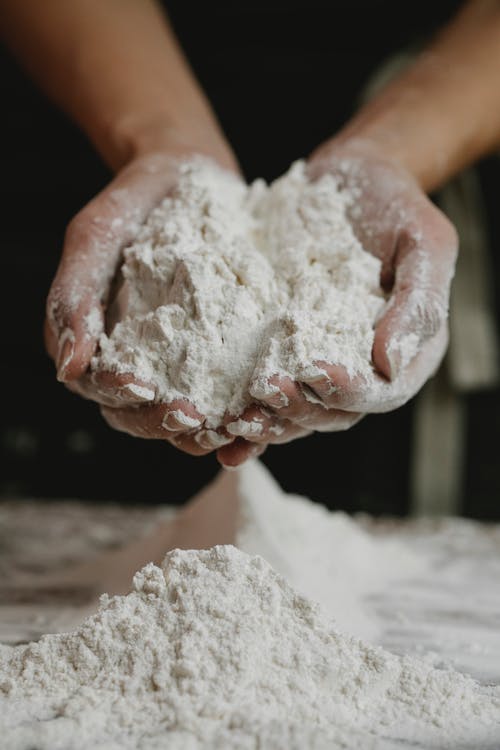I’m going to kick things off by explaining why flour isn’t just an ingredient; it’s the foundation of countless culinary creations from bread to cakes and even sauces. Flour comes from grinding grains, nuts, or seeds into a fine powder, but not all flours are created equal. The grain origins of common flours, like wheat, rice, or almonds, significantly influence the texture, flavor, and nutrition of your dishes.
That’s going to include a talk about gluten – the protein that’s key in baking. Gluten helps dough to rise and keeps its shape, providing that delightful chewiness in bread. Understanding how gluten content varies across different types of wheat flours can help you choose the right one for your recipe.
You’re going to find out about practical storage tips, too. Storing flour in a cool, dry place prevents it from spoiling and helps maintain its quality. Whether it’s in an airtight container on your kitchen shelf or in a sealed bag in the freezer, proper storage will keep your flour fresh and ready for action.
Now, as we step into the diverse world of wheat flour in the next section, remember this isn’t just about baking. Flour also acts as a thickener in soups and gravies, or as a batter in frying. Wheat flour is incredibly versatile, and you’re about to discover the various forms it takes, from the reliable all-purpose to the robust whole wheat.
Wheat Flour Decoded: From All-Purpose to Whole Wheat
I’m going to break down the world of wheat flours, so you’ll be able to navigate the baking aisle like a pro. It’s a spectrum that stretches from the ubiquitous all-purpose flour to the dense and nutritious whole wheat, with specialty flours sandwiched in between.
All-purpose flour is the Swiss Army knife of flours. You’re going to find out about its versatility in recipes from bread to cakes, thanks to its moderate protein content which strikes a balance between firmness and tenderness in baked goods.
When you step into the realm of bread flour, you’re dealing with a powerhouse of protein. That’s going to include recognizing its role in creating those perfect chewy textures in pizza doughs and artisan breads. However, this isn’t just about making yeasty wonders; bread flour can fortify other recipes when you need a stronger structure.
Let’s not overlook the finesse of pastry flour and cake flour. These are the go-to’s if you’re after delicacy in your baked creations, producing light and tender results. I’ll explain the science behind their fine, soft texture and how it transforms your confections.
On the other hand, whole wheat flour offers a fuller flavor with the nutritional bonus of fiber and vitamins. It’s a choice that resonates with health-conscious bakers and those looking to add a robust taste to their baked goods. But remember, this flour can be quite dense, so it often requires a little extra care in recipes.
In my opinion, getting familiar with these wheat flours can vastly improve your cooking and baking experiences. Don’t worry too much about experimenting — you can always adjust your approach down the road. Next up, we’re going beyond the wheat field and looking into the exciting world of non-wheat flour alternatives.
Beyond Wheat: Discovering Non-Wheat Flour Alternatives
If you want to explore the expansive world of baking and cooking beyond traditional wheat flour, you’re going to find out about a variety of non-wheat flour alternatives that not just cater to gluten sensitivities but also add distinct flavors and textures to your dishes.
Gluten-free options are becoming increasingly popular, and among them, almond flour, coconut flour, and rice flour stand out. Almond flour, made from finely ground blanched almonds, provides a nutty flavor and is fantastic in cookies and cakes. Coconut flour, on the other hand, is high in fiber and lends a delicate, tropical essence, perfect for muffins and pancakes. Rice flour, often used in Asian cuisine, is excellent for frying and making smooth batters.
You may wonder how to substitute non-wheat flours in recipes since they behave differently than wheat flour. A good starting point is understanding that they often require different amounts of liquid and can alter the texture of your baked goods. I’m here to help you with that transition, offering tips on substitution ratios and adjustments needed for successful gluten-free baking.
But these flours aren’t just for those avoiding gluten. They can bring new tastes and nutritive values to the table. For instance, almond flour is rich in protein and vitamin E, while coconut flour offers beneficial fiber. Incorporating these into your pantry means diversifying your dietary options.
Now don’t worry too much about perfecting your use of non-wheat flours from the get-go. As with any ingredient, it takes a little experimentation to get it just right. Your first attempt at using coconut flour isn’t going to be your last, and over time, you’ll fine-tune your skills. And as you get comfortable with these alternatives, you’re ready to take on any recipe with confidence, leading into mastering flour in your kitchen with practical and savvy approaches.
Mastering Flour in the Kitchen: Tips and Tricks for Perfect Baking Results
If you want to yield the best baking results, knowing how to handle flour is as crucial as the type you choose. Precision is your best friend when it comes to measuring flour. Dipping the measuring cup directly into the flour bag often leads to using more than your recipe requires. Instead, I recommend spooning the flour into the measuring cup and leveling it off for just the right amount.
Sifting is another technique that should not be underestimated. Sifting not only removes any lumps but also aerates the flour, which can lead to lighter baked goods. This step is essential when working with cake flour or making delicate pastries.
When switching flour types, remember that each flour behaves differently, especially in terms of absorbing liquids. You might have to tweak the amount of liquid in your recipe to get the dough or batter to the right consistency. It’s better to start with less liquid and gradually add more if needed, rather than trying to correct a mixture that’s too wet.
As for troubleshooting common baking issues, if you find that your bread isn’t rising enough, it could be due to a lack of gluten structure, which can be helped by adding a little more high-protein bread flour. On the other hand, if your cookies are spreading too thin, they might benefit from a switch to a flour with less protein, like cake flour, to yield a firmer dough.
Remember, your first attempt doesn’t need to be your last. Baking is as much art as it is science. Few flours are truly interchangeable one-for-one, so give yourself the freedom to experiment. And just don’t focus too much on perfection; small tweaks can lead to delicious discoveries.
Choose something that resonates with you and your dietary needs. Whether you’re going for the nutritional powerhouse of whole grain flours or exploring gluten-free alternatives, there’s a lot of opportunity in mastering their uses. Keep practicing, and you’ll be a flour expert in no time!


